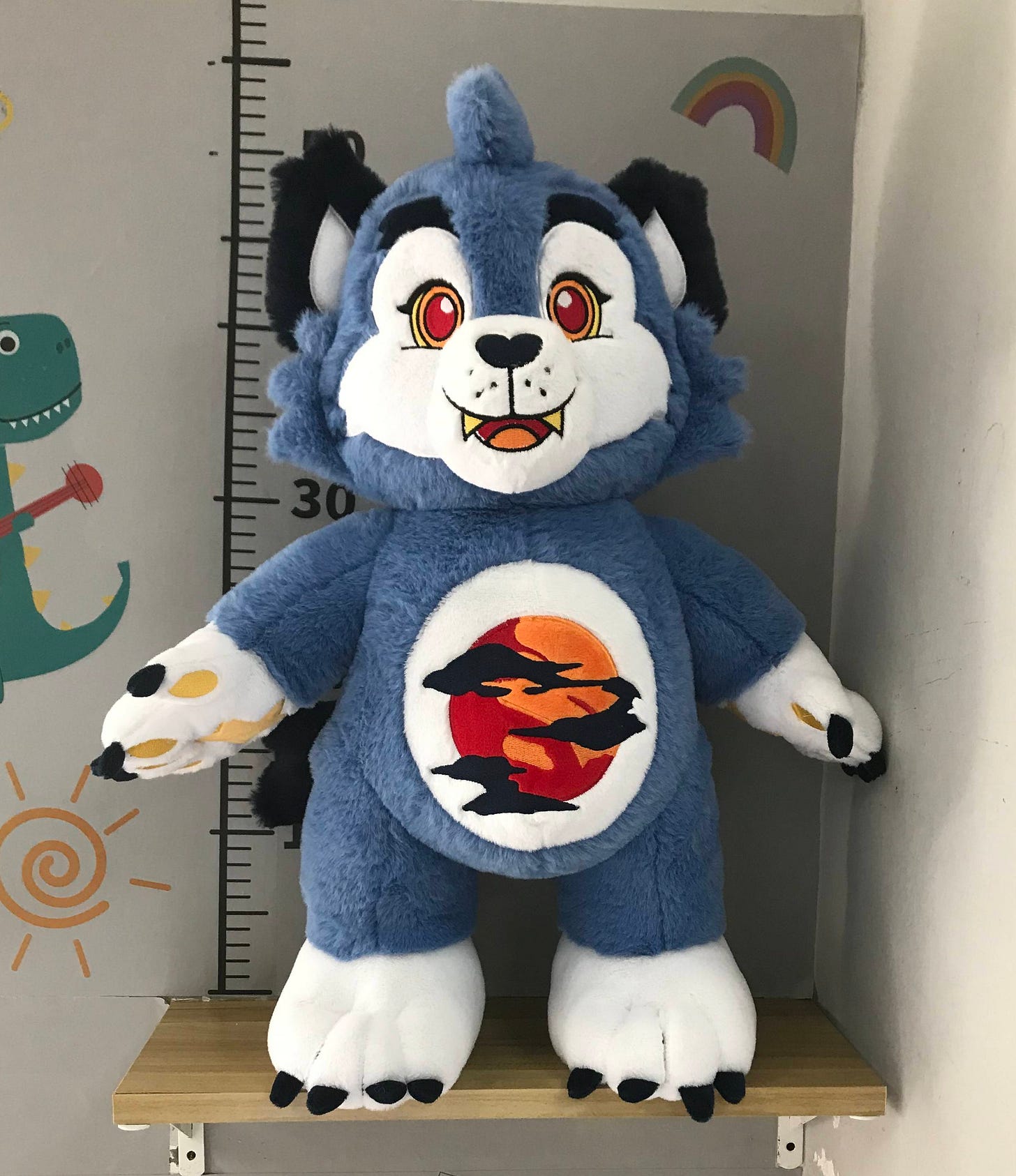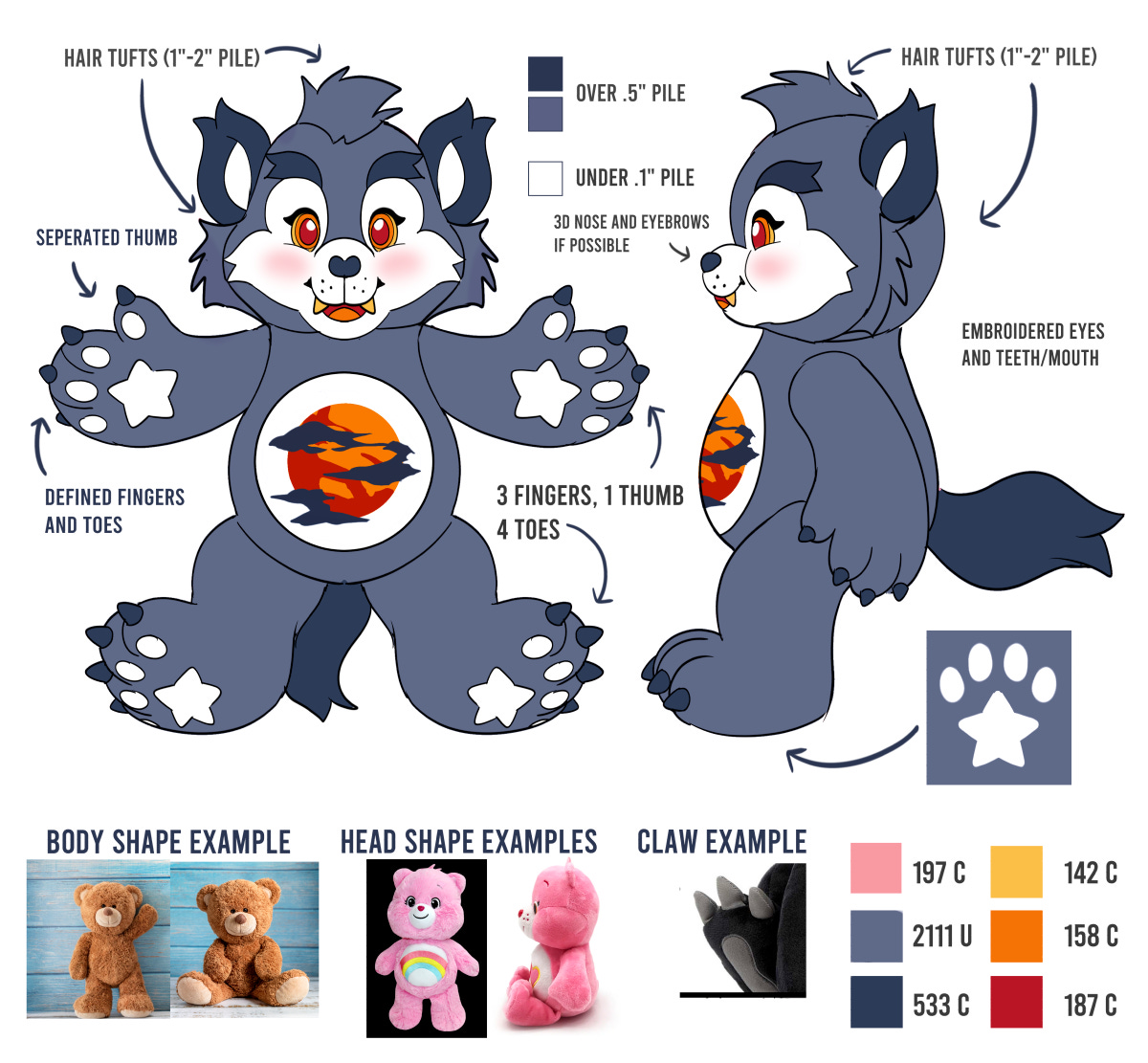Hello friends! I spent six hours on the road today and the entire time I was thinking about how cool it would be to compile some of the things I’ve learned about plushie making so far into one handy list. So here we are!
Disclaimer: I've been at this for almost a year now and I am by no means an expert. This is just some stuff I've learned that may not be obvious when first starting out.
I. The Design
While this part is fairly straightforward, I have learned a few tips for getting my ideas across in as few iterations as possible.
You’ll want to draw big, and provide your manufacturer with an uncompressed PSD or other layered file to make their lives a little easier. Having multiple angles of your design is a must, and photo references of existing toys helps tremendously if you have a very specific final product in mind.




One big mistake I’ve made a few times now is leaving outlines where I don’t want them! The designers can’t read your mind, so if you don’t want the eyes and/or other embroidered elements to be outlined be sure to specify and save you both the headache.
Specifying fur length and texture is also important or else you arrive at something like the sample above. I wanted fluffy cheeks with a long pile and got shaped fabric instead. Fortunately the designer was very accommodating and made all the revisions I requested free of charge.
II. Finding a Manufacturer
You have your design, great! Now it’s time to find someone who can make it. This may be the most daunting part of the process. If you're a sole proprietor like me, odds are you don't have the means to order 3000+ plushies in one go even with crowdfunding, so its going to be next to impossible to find a domestic plush manufacturer willing to work with you.
The good news is, alibaba is a great place to find overseas manufacturers with low MOQs (minimum order quantities, usually around 100 pieces or so), making the barrier for entry much much lower.
You can start by submitting a RFQ (request for quotation) which will prompt manufacturers to send you quotes based on your design and specifications. Alternatively you can use the platform to search for manufacturers on your own and message a select handful based on their reviews, years in business, and transaction history (this is what I did since I didn't understand RFQs at the time).
I would typically request the sample fee, along with the cost per piece for 100, 300, and 500 items. This can vary pretty wildly by manufacturer, with a 50cm plush costing anywhere from $200-$250 to prototype and ship and then $15-$20 per piece when ordered in bulk.
It isn't uncommon or unwise to shop around, ordering samples from several different manufacturers to compare the quality vs. price and find what works for you.
One more important thing to note: when reaching out for the first time, keep it simple!! There is often a language barrier that can make things a bit confusing for both parties. I prefer to let the representatives ask me questions so I know exactly what to send instead of inundating them with unnecessary information or information that may be lost in translation.
III. Communication, Revisions
Once you've found a company and price you like, discussed everything and paid for the sample, then comes the waiting. Lead time on the first sample again varies wildly by manufacturer. Some send WIPs and give you the option to make revisions before seeing the final product, others send a completed sample and then allow you to make revisions.
It usually takes about a week or two to see the first photos. In my experience this is both exciting and sometimes a little discouraging because this where you find out what works, what you can salvage, and what ideas you have to chuck because they just don’t look great in the round.
With the careweres I learned very quickly that I had to be clear but also flexible in order to arrive at a final product I was proud to share. This meant removing the open mouth (embroidery is stiff and will flatten out a shape that's meant to have a taper), going with a plastic nose, finding reference photos of existing plushies to better convey what I meant as well as photoshopping the sample photos they sent me.
I've had some incredible happy accidents while working around the limitations of plush making, though! For example, the original careweres lacked white paws but the length of the fur would have limited the amount of detail the manufacturer could add.
Switching to a shorter pile (the white bits) allowed them to keep the claws and ultimately became a pretty integral part of the carewere look™.
Most manufacturers specify that they allow up to two revisions, but in my experience they’re willing to make as many as necessary as long as what you’re asking for is a part of the original design. Any wild deviations from your drawings will often result in additional fees.
The carewere went through four revisions, and then I paid for another two after the first sample was shipped to me and I noticed a few more things I was unsatisfied with.
IIII. Safety Testing and Shipping
Fortunately the safety testing process is fairly painless and (at least in my experience) can be initiated by your manufacturer for a set fee per design (approximately $200 in my case). You can pay for these certificates piecemeal (for instance, if you only plan to sell in the US and therefore only need an ASTM certification) or you can pay for additional testing to sell worldwide.
Importing your plushies into your country is also painless (again, in my very limited experience). I opted to let the manufacturer handle all of the customs information and freight management, so all I have to do is ensure I have a place to put them when all the boxes arrive.
If you’re not sure what shipping method your manufacturer plans to use, I recommend asking upfront so you aren’t slapped with any surprise fees later.
As for the cost of shipping itself it varies depending on the method you use (air vs. sea) and the size of your shipment, but in general it seems to be anywhere from 1/3 the cost of your plushies to 1/2 (the shipping fees for the careweres amounted to a whopping 8k 😳).


I’m sure I missed a lot of things in the interest of brevity, so feel free to leave a comment if you have any additional questions!









this is SUPER helpful, but i have been looking around for tips on sketching out the design of a plush before i even start to transfer it to an actual item. do you have any tips or recommendations when it comes to designing a plush?
This is incredibly helpful, thank you! I want to design and get plush manufactured someday, and it's a bit hard to find information on how that process works.
(Also, I hope we see that Werewolf design fully realized as a plush someday, I've always wanted a scary-but-cuddly Werewolf to hug!)